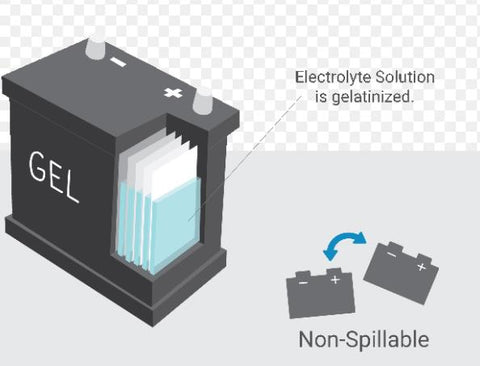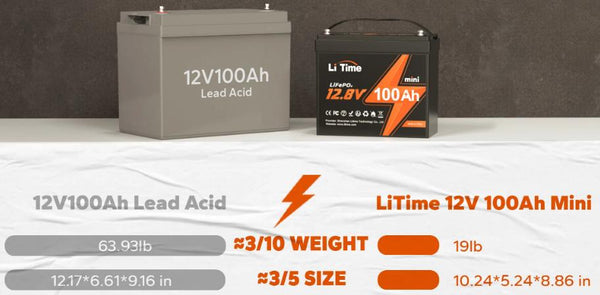Electric wheelchairs offer individuals with mobility impairments independence and freedom of movement. However, these wheelchairs depend on high-quality batteries to function optimally. Choosing the right battery can enhance an individual's mobility experience by providing better performance, longer battery life, and faster charging speeds. In this article, we will explore different types of wheelchair batteries, provide maintenance tips, and discuss why LiFePO4 is a better option.
Voltage of Wheelchair Batteries
When it comes to wheelchair batteries, voltage and chemistry are two crucial factors to take into account. Firstly, all wheelchair batteries operate on 12 volts, but most electric wheelchairs utilize a 24-volt system, which requires two 12-volt batteries in sereis connection to run efficiently.
In order to ensure optimal performance of the wheelchair, it is important to purchase batteries that have the same chemistry and battery capacity, which is measured in amp hours (Ah). If you're unfamiliar with this term, amp hour represents the amount of amperage a battery can provide for one hour. The more amp hours in a battery, the longer your wheelchair will remain operational.
Therefore, when shopping for wheelchair batteries, make sure to choose batteries that possess similar chemical compositions and amp hour ratings to guarantee that they meet the requirements of your wheelchair and provide an extended runtime.
Types of Wheelchair Battery
Electric wheelchairs rely heavily on deep-cycle batteries to power their motor and control systems. There are several types of deep-cycle batteries available in the market, and each has unique features and specifications that determine their suitability for specific wheelchairs and applications. There are 3 main types of battery widely used nowadays, lead-acid battery, AGM battery and Gel cell battery.
- Lead-acid batteries: These are the most common type of batteries and are preferred for their affordability and reliability. They come in two sub-types; flooded lead-acid batteries and sealed lead-acid batteries.

- AGM batteries: These batteries are known as Absorbent Glass Mat (AGM) batteries and are sealed lead-acid batteries that use a glass mat to absorb and hold the electrolyte.

- Gel cell batteries: These are an improved version of sealed lead-acid batteries and contain an electrolyte that is immobilized in a gel state. They are maintenance-free and have a longer lifespan than flooded lead-acid batteries.

Battery Maintenance and Care
Proper maintenance and care of a wheelchair battery are crucial to optimizing its performance and extending its lifespan. Here are some tips for maintaining and caring for your wheelchair battery:
- Charge Regularly: Ensure that your wheelchair battery is charged regularly and not allowed to discharge fully. It’s best to charge your battery when it reaches 50% capacity to extend the battery life.
- Avoid Overcharging or Undercharging: Overcharging or undercharging can damage the battery and cause it to have a shorter lifespan. It's important to monitor the charging process and disconnect the charger when the battery is fully charged.
- Keep Battery Clean: Keep the battery clean by wiping it with a damp cloth periodically. Dirt and debris can collect on the battery, leading to corrosion or reduce battery efficiency.
- Store Correctly: If you're storing your wheelchair battery for an extended period, make sure it's stored in a cool and dry place. Do not store the battery in direct sunlight or a hot car as it can damage the battery.
- Check Connections: Check the battery connections regularly to ensure they are clean and secure. Loose or corroded connections can prevent the battery from working correctly, leading to reduced battery life and performance.
- Use the Right Charger: Always use the correct charger designed for your wheelchair battery. Using an incorrect charger can damage the battery and shorten its lifespan.
- Follow Manufacturer Guidelines: Always follow the manufacturer's guidelines for maintaining and caring for your wheelchair battery. This includes charging recommendations, cleaning instructions, and storage guidelines.
By following these simple tips, you can prolong the lifespan of your wheelchair battery and optimize its performance. Remember, regular maintenance and care are essential for maximum mobility and independence.
Advancements in Wheelchair Battery Technology
Recent advancements in wheelchair battery technology have led to longer-lasting and more efficient batteries. For example, lithium-ion phosphate (LiFePO4) batteries are an emerging technology that offers better performance and longevity than traditional lithium-ion batteries. These batteries are more lightweight and have a longer lifespan, which can provide greater mobility for users.
Why Upgrading to a LiFePO4 Battery is Beneficial for Wheelchair Users
1. Lightweight
Wheelchairs are designed to be as light as possible to make it easier for users to move around and reduce the risk of injuries. Adding a heavy battery can significantly increase the overall weight of the wheelchair, making it more difficult to push or maneuver.
A lighter battery, such as a LiFePO4 battery, can help reduce the overall weight of the wheelchair, making it easier for the user to navigate through tight spaces and inclines. This can result in less fatigue and strain on the user's arms, shoulders, and back, improving their comfort and reducing the risk of injuries.
Furthermore, the weight distribution of the battery can also affect the stability and balance of the wheelchair. A heavier battery at the front or the back of the wheelchair can cause instability and tipping hazards. Therefore, selecting a lightweight and compact battery with proper placement and weight distribution can improve the stability and safety of the wheelchair.
LiFePO4 batteries are much lighter compared to lead-acid batteries. The weight of a LiFePO4 battery is typically 40-50% lighter than an equivalent lead-acid battery. For example, a typical 12V 100Ah LiFePO4 battery weighs around 30 pounds while an equivalent lead-acid battery could weigh anywhere from 60 to 70 pounds. Litime 12V 100Ah mini weights only 19 lbs, which is a better choice.

The weight difference between the two types of batteries may not seem significant in everyday life, but for a wheelchair user who has to push or propel themselves, even a few pounds can make a big difference. A lighter battery means that the overall weight of the wheelchair is reduced, making it easier to maneuver and less tiring for the user.
In addition to weight, LiFePO4 batteries also have a higher energy density, which means they can store more power in a smaller size than traditional lead-acid batteries. This results in longer run times and increased range for the wheelchair, without adding extra weight.
Overall, the weight advantage of LiFePO4 batteries over lead-acid batteries makes them an ideal choice for wheelchairs, as it provides greater mobility and comfort for the user.
2. Longer Lifespan
The lifespan of a battery is a crucial factor to consider when choosing a battery for a wheelchair as it affects the overall cost of ownership and reliability of the equipment. Normally, a fully charged wheelchair battery is designed to provide around eight hours of use and last between one and two years.
Lithium Iron Phosphate (LiFePO4) batteries have a significantly longer lifespan compared to traditional lead-acid batteries. LiFePO4 batteries can last up to four times longer than lead-acid batteries, with an expected lifespan of more than 4000 cycles. In contrast, lead-acid batteries generally last between 500 to 800 cycles before needing replacement.

For wheelchair users, a longer battery life means fewer replacements, less downtime, and reduced maintenance costs. It also means that the battery will last for years, providing reliable power and consistent performance.
Moreover, LiFePO4 batteries have a low self-discharge rate, which means they can retain their charge for up to six months without losing power. This feature is especially important for wheelchair users who may not use their equipment regularly.
3. Maintenance-free
Traditional lead-acid batteries require regular maintenance and monitoring to ensure optimal performance, reliability, and lifespan.
Lead-acid batteries need to be periodically checked and topped off with distilled water to maintain the proper electrolyte levels. In addition, they require consistent charging to avoid sulfation and ensure full capacity, as well as equalizing to prevent stratification of the electrolyte and extend their life.

In contrast, LiFePO4 batteries require little to no maintenance. They do not need to be topped off with water, do not suffer from sulfation or stratification, and have a low self-discharge rate. LiFePO4 batteries are also less prone to overheating and do not emit gases during operation, making them safer and more convenient to use.
The low maintenance requirements of LiFePO4 batteries provide greater convenience and peace of mind for wheelchair users. They do not need to spend time and effort maintaining or monitoring the battery, which allows them to focus on other important tasks or activities. Additionally, it reduces the risk of damage or failure due to improper handling or maintenance, minimizing the likelihood of downtime or costly repairs.
Overall, low maintenance is an important feature that contributes to the overall reliability, safety, and convenience of a wheelchair battery. Choosing a battery with low maintenance requirements like LiFePO4 can reduce the hassle and cost associated with battery maintenance and ensure consistent and reliable performance over its lifespan.
4. Environmentally Friendly and Advanced Safety Features
Lithium Iron Phosphate (LiFePO4) batteries are considered more environmentally friendly than traditional lead-acid batteries due to the following reasons:
- Lower toxicity: LiFePO4 batteries contain fewer toxic chemicals such as lead, cadmium, and sulfuric acid than lead-acid batteries. These chemicals can cause environmental pollution and health hazards if not disposed of properly.
- Recyclability: LiFePO4 batteries are fully recyclable, which means that they can be processed and reused to make new batteries or other products. This reduces waste and conserves resources compared to lead-acid batteries, which have a lower recycling rate.
- Energy efficiency: LiFePO4 batteries are more energy-efficient than lead-acid batteries, which means they require less energy to charge and discharge. This results in lower greenhouse gas emissions, reducing the carbon footprint associated with the battery's lifecycle.
For wheelchair batteries, choosing an environmentally friendly option like LiFePO4 can benefit both the user and the environment. LiFePO4 batteries have a longer lifespan, require less maintenance, and are lighter, providing greater mobility and convenience for the user. In addition, they are safer and less toxic, reducing the risk of environmental pollution and health hazards during disposal.
Conclusion
When it comes to electric wheelchairs, the right battery is essential for optimal performance, reliability, and safety. Various factors come into play when selecting a suitable battery, including voltage, chemistry, amp-hour rating, and type. Proper maintenance and care are also crucial in extending the battery's lifespan and maintaining consistent performance.
Recent advancements in battery technology have led to the emergence of LiFePO4 batteries, which offer improved performance, longer lifespan, and low maintenance requirements compared to traditional lead-acid batteries. LiFePO4 batteries are lighter, more energy-efficient, and environmentally friendly, making them an ideal choice for electric wheelchair users seeking more mobility, convenience, and comfort.
Choosing the right battery for your electric wheelchair is essential to ensure that you get the most out of it. By considering the factors discussed in this article and adopting the maintenance tips provided, you can optimize the performance and lifespan of your wheelchair battery, improving your mobility experience and quality of life.
-----------------------------------------------------------------------------------------------
You may also like:
Everything About Battery Terminal Corrosion And How LiFePO4 Batteries Can Help Prevent It
Top 10 Mistakes To Avoid When Building Your First Solar Power System








